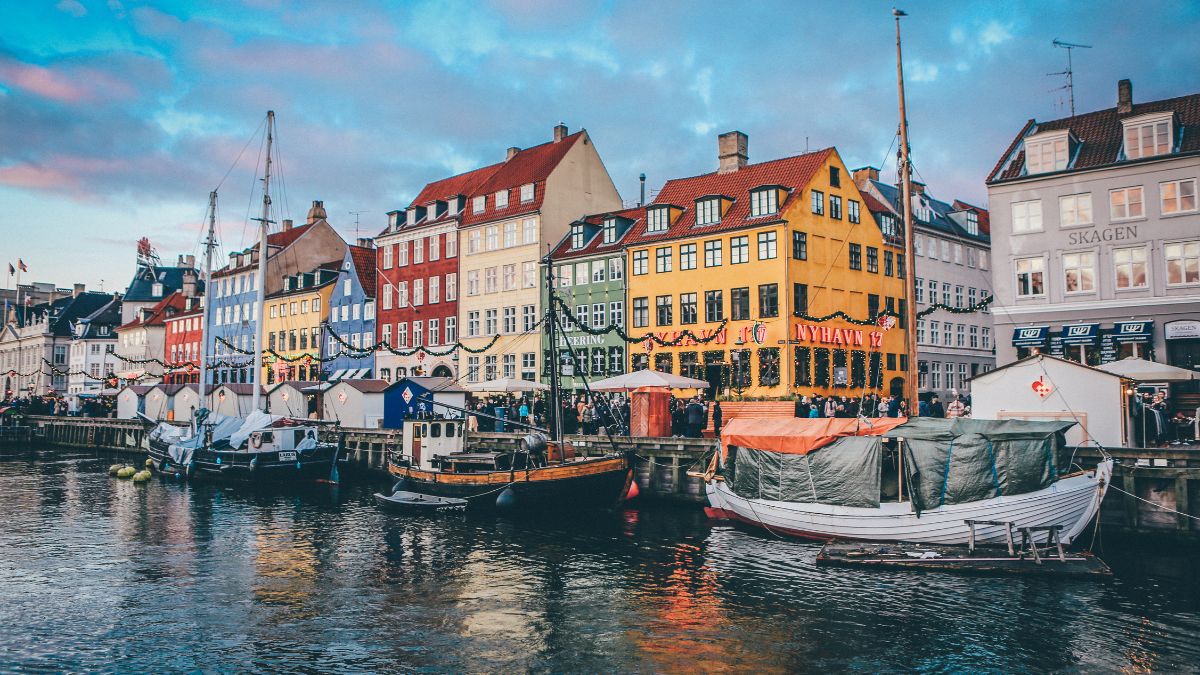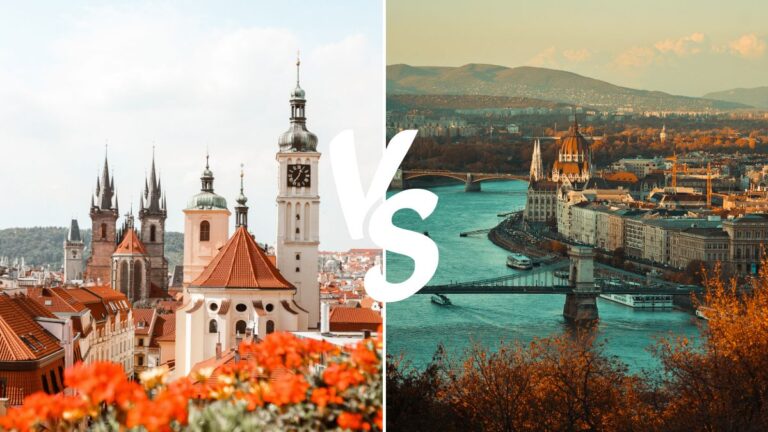Worst Time to Visit Denmark: Dealing with Dark Winters and Tourist Crowds

As participants in Amazon Associates and other programs, we earn from qualifying purchases. This comes at no additional cost to you. For more details, see our Affiliate Disclosure.
Denmark, with its fairy-tale castles, sleek design, and a penchant for coziness, captivates the hearts of many globetrotters. However, it’s no secret that even the most enchanting of destinations can have their challenging periods. In Denmark, these challenges often present themselves in the form of long, bleak winters and overwhelming tourist crowds.
In this exploration, we take you through these less-than-ideal times, equipping you with the knowledge you need to make the most of your Danish adventure.
The Long Night: Denmark’s Dark Winters Explained
Denmark, being a part of the high northern hemisphere, is no stranger to long and dark winters. This phenomenon, known as ‘Polar Nights,’ is a unique aspect of Scandinavian countries where the sun barely peeps above the horizon, resulting in shorter daylight hours.
From late November to late January, the daylight in Denmark is often limited to a mere 7 hours, with the sun rising around 8:30 AM and setting as early as 3:30 PM. This drastically reduced sunlight can result in a phenomenon called Seasonal Affective Disorder (SAD), a type of depression that’s related to changes in seasons, primarily affecting people during the same time each year. It’s often linked with the reduced exposure to sunlight which might disrupt your body’s internal clock, leading to feelings of depression.
Additionally, the weather during these months can be particularly harsh. The average temperature hovers around freezing, and snowfall, while not extreme, is a common sight. There’s also a significant amount of overcast weather, which combined with the short days, can lead to a sense of persistent twilight.
Yet, it’s not all gloom and doom. The Danish people have cultivated a culture that embraces these long, dark winters. This is epitomized in their concept of ‘Hygge,’ a uniquely Danish term roughly translated as ‘coziness,’ which is a way of creating warmth, connection, and contentment through simple pleasures, even in the midst of the darkest winter.
From lit candles flickering in windows to homes adorned with warm textiles, Denmark is a country that not only endures its long winters but also thrives in them. But for the unprepared visitor, the lack of light and the cold can certainly be challenging.
Managing in Minimal Light: Practical Tips
Navigating the minimal daylight during Denmark’s winter months can certainly be a challenge, especially if you’re accustomed to longer days and more sunlight. However, with a few practical tips and a proactive approach, you can manage and even embrace the long nights.
- Plan your day early: With limited daylight, it’s beneficial to start your day early to make the most of the sunlight. Most of the outdoor activities and sightseeing should be planned for the daylight hours.
- Embrace indoor activities: Museums, art galleries, cafes, and other indoor attractions are not impacted by the reduced daylight. These places often have extended winter hours and are excellent options for when the sun sets early.
- Equip yourself with Vitamin D: The lack of sunlight can result in Vitamin D deficiency, leading to fatigue and other health issues. Consider supplements or Vitamin D-rich foods to compensate for the lack of natural light.
- Stay active: Regular physical activity can boost your mood and energy levels, counteracting the effects of the dark weather. Many Danes continue to cycle, their preferred mode of transport, even during the winter months. Consider renting a bike to keep yourself moving.
- Enjoy the Danish Hygge: Make the most of the cozy indoor environments. Sip on a hot drink in a local café, enjoy reading a book by candlelight, or partake in local cooking classes. The concept of hygge is all about enjoying the simple, comfortable moments, so create your own!
- Invest in proper winter clothing: Warm, waterproof clothing and good quality footwear are essentials for braving the winter. Dress in layers to adapt to changing indoor and outdoor temperatures.
- Take advantage of winter festivities: Denmark is known for its magical Christmas markets, festive lights, and holiday celebrations. These events can brighten up even the darkest of days.
While the reduced daylight can be daunting initially, many visitors find a unique charm in the peaceful, slower pace of life that the Danish winter offers. With the right mindset and preparation, you can turn the experience into an unforgettable journey.
How to Dress for Danish Winter: Staying Warm and Cozy
Danish winters can be quite cold, with temperatures often hovering around freezing, accompanied by biting winds. Therefore, dressing appropriately is vital to keep warm and comfortable during your visit. Here are some tips on how to dress for the Danish winter:
- Layer up: The secret to staying warm in cold climates is layering. Start with a thermal base layer that fits snugly to your body and is designed to retain heat while wicking away moisture. Over this, add a middle layer like a sweater or fleece for added insulation, and finally, finish with a waterproof or water-resistant outer layer to protect against wind, rain, or snow.
- Choose the right materials: Not all fabrics are created equal when it comes to keeping warm. Wool and fleece are excellent insulators and retain heat well. Synthetic materials like polyester can be effective for base layers, as they’re good at wicking away moisture.
- Protect your extremities: A good percentage of body heat is lost through the head, hands, and feet, so it’s important to keep these areas covered. Choose a warm hat that covers your ears, gloves or mittens to protect your hands, and thick, warm socks (preferably wool) for your feet.
- Invest in quality footwear: Good footwear is essential in the cold, potentially wet conditions of a Danish winter. Waterproof boots with non-slip soles are the best choice to keep your feet dry and prevent slips or falls on icy surfaces.
- Don’t forget a scarf and earmuffs: A scarf can add warmth and protect your neck, where your jacket may not provide enough coverage. Earmuffs can add an extra layer of protection for your ears against the cold wind.
- Wear a good quality winter coat: A warm, waterproof winter coat is a must-have. Down jackets provide excellent insulation, but there are also high-quality synthetic alternatives for those who prefer not to use animal products.
- Stay dry: Danish winters can be damp, so choose outer garments that are waterproof or at least water-resistant.
Danish winter weather can be unpredictable, so always be prepared with appropriate clothing options. With the right attire, you’ll be well-equipped to brave the chilly conditions and fully enjoy everything Denmark has to offer.
Tourist Influx: The Peaks and Valleys of Denmark’s Busy Season

Denmark, with its blend of old-world charm and modern design, attracts tourists from around the globe. The country experiences its highest tourist influx during the summer months, from June to August, when the weather is warm and daylight extends up to 17 hours a day. However, this peak season brings with it both opportunities and challenges.
Peaks of Busy Season
- Ideal Weather: Summers in Denmark are relatively mild, with average temperatures ranging from 15 to 25 degrees Celsius, providing comfortable conditions for sightseeing and outdoor activities.
- Extended Daylight: With the sun setting as late as 10 PM during midsummer, visitors have more daylight hours to explore and enjoy the country’s attractions.
- Festivals and Events: Summer is the season for numerous cultural events and festivals in Denmark. From the colorful Copenhagen Pride to the popular Roskilde Music Festival, these events add a vibrant, celebratory spirit to any visit.
Valleys of Busy Season
- Overcrowding: Popular tourist spots, particularly in cities like Copenhagen and Aarhus, can get quite crowded during peak season. This can lead to long queues at attractions, packed public transportation, and a general hustle and bustle that some may find overwhelming.
- Increased Prices: High demand during the summer often leads to increased prices for accommodation, flights, and sometimes even at restaurants and attractions.
- Availability: Due to the influx of tourists, finding available hotel rooms, restaurant reservations, or tickets to certain attractions can be difficult without advanced planning.
While the tourist influx can create a lively and exciting atmosphere, it’s also important to consider the potential downsides. Careful planning, including booking accommodations and attractions in advance, can help mitigate some of these challenges and ensure a smooth and enjoyable visit to Denmark.
Navigating the Crowds in Copenhagen and Other Cities
During the peak tourist season, navigating the crowds in Denmark’s popular cities, especially in the capital city, Copenhagen, can feel overwhelming. Here are some practical tips to help you enjoy the urban experience while managing the hustle and bustle.
- Plan Your Day Wisely: Try to visit popular tourist sites early in the morning or later in the afternoon when they are less crowded. Many people tend to tour in the middle of the day, so shifting your schedule slightly can help you avoid the busiest times.
- Use Public Transportation: Danish cities, particularly Copenhagen, have excellent public transportation systems. Using buses, trams, or trains can often be quicker and more efficient than driving in busy city traffic. Plus, it’s a great way to experience the city like a local!
- Bike Around: Biking is a popular mode of transport in Denmark. Renting a bike can be a fun and efficient way to navigate the city, plus you’ll be participating in a cherished Danish tradition.
- Book in Advance: If there are certain attractions, restaurants, or shows you definitely don’t want to miss, book them in advance. This will guarantee your spot and save you from potential disappointment.
- Explore Lesser-Known Attractions: While iconic sites draw the majority of tourists, every city has its hidden gems. Do some research and discover off-the-beaten-path attractions for a more relaxed experience.
- Stay Outside the City Center: Consider booking your accommodation in a neighborhood outside the main city center. You’ll escape some of the noise and crowd, and get to explore a less touristy part of the city.
- Patience is Key: Remember, everyone is there to enjoy their holiday, just like you. Crowds are part and parcel of visiting popular cities during peak season, so take it in stride and keep a positive attitude.
By adopting these strategies, you can make the most of your city visit, immersing yourself in the vibrant Danish urban life while managing the challenges posed by large crowds.
Quiet Corners: Escaping the Crowds in Denmark
Even during the busy tourist season, Denmark has plenty of quieter spots where you can escape the crowds and enjoy a more peaceful experience. Here are some of the country’s less visited, but equally captivating, attractions and regions.
Ærø Island: A part of the South Funen Archipelago, Ærø is a picturesque island known for its charming, colorful houses, beautiful beaches, and serene landscapes. It’s a bit off the usual tourist trail, which adds to its appeal.
Skagen: Located in the northernmost part of Denmark, Skagen is renowned for its unique light quality that has drawn artists for centuries. It offers peaceful beaches, classic Danish architecture, and the intriguing natural phenomenon of two seas meeting at Grenen.
Ribe: Considered the oldest town in Denmark, Ribe provides a step back in time with its well-preserved medieval architecture and quiet cobblestone streets.
Møn’s Klint: These dramatic white cliffs rising above the Baltic Sea are a must-see natural wonder. While it’s a known location, its relative remoteness helps control the crowd size.
Bornholm: This island, situated in the Baltic Sea, is known for its idyllic fishing villages, round churches, and glass and ceramic arts. It offers a slower pace of life perfect for those seeking peace and tranquillity.
The Danish Lake District: Located in the heart of Jutland, the Lake District is known for its stunning lakes, forests, and hills. It’s a haven for outdoor enthusiasts and offers plenty of quiet corners to explore.
National Park Thy: This large, coastal national park in North Jutland offers diverse landscapes, including dunes, heaths, and forests. It’s ideal for hiking, bird-watching, or simply enjoying the calm of nature.
These places might not have the same abundance of amenities as larger cities, so planning ahead is crucial. With a spirit of adventure and a desire for tranquillity, these less crowded corners of Denmark provide a refreshing contrast to the bustling tourist hotspots.
Off-Peak Travel: Considerations and Benefits
Traveling to Denmark outside of the peak summer season, also known as off-peak travel, can offer a different perspective and a range of benefits. While there may be considerations such as weather and shorter daylight hours, the advantages often outweigh the drawbacks for those who prefer a more serene, authentic experience. Here are some key points to consider.
Considerations for Off-Peak Travel
- Weather: Depending on when you visit, the weather can range from cold and snowy in the winter to mild in the spring and autumn. It’s essential to come prepared with suitable clothing.
- Shorter Daylight Hours: Particularly in late autumn and winter, daylight hours are significantly reduced, which may require some adjustments to your sightseeing plans.
- Some Attractions May Be Closed or Have Reduced Hours: Especially in smaller towns and countryside areas, some attractions, restaurants, and shops may have shorter opening hours or close during the off-peak season.
Benefits of Off-Peak Travel
- Fewer Crowds: Traveling outside of the peak season means fewer tourists at popular sites, giving you the opportunity to enjoy attractions without the hustle and bustle.
- Lower Prices: With lower demand, prices for accommodations, flights, and sometimes attractions are often significantly reduced.
- Greater Availability: With fewer tourists, it’s easier to find availability in accommodations and restaurants, and there’s often no need to queue for popular attractions.
- Authentic Experience: With fewer tourists, you have a better chance of experiencing the local culture and way of life.
- Unique Attractions: Each season brings its unique attractions, like the magical Christmas markets in winter, the beautiful fall foliage in autumn, and the blooming flowers in spring.
Off-peak travel to Denmark can be a rewarding experience, full of unique opportunities. It offers a chance to explore the country’s rich culture and beautiful landscapes at your own pace, without the stress of navigating through large crowds.
Strategic Planning: Optimizing Your Danish Vacation
Whether you’re visiting Denmark in the height of summer or the depths of winter, strategic planning can help optimize your experience, ensuring that you make the most of your trip. Here are some tips to help you plan effectively:
- Research the Season: Depending on the time of year you’re visiting, different attractions and experiences will be available. Ensure you know what to expect in terms of weather, daylight hours, and seasonal events so you can plan accordingly.
- Prioritize Your Interests: Denmark offers a wide range of activities, from exploring historical sites and museums to enjoying nature hikes and cycling routes. Determine your interests and priorities ahead of time to create a focused itinerary.
- Book in Advance: For popular attractions, accommodations, or restaurants, booking in advance can save you from disappointment, especially during peak season. This is also true for transportation if you plan to travel around the country.
- Be Flexible: While planning is essential, so is flexibility. Having some open spaces in your itinerary allows for spontaneous exploration or relaxation time.
- Consider Less Visited Regions: To avoid crowds and enjoy a more peaceful experience, consider visiting lesser-known towns and regions. Often, these areas offer unique attractions and a more authentic taste of Danish life.
- Plan for Rest Days: Don’t forget to allocate some downtime in your itinerary. Exploring a new country can be exciting but also tiring. Having some leisurely days can help you relax and absorb your experiences.
- Stay Connected: Consider getting a local SIM card or ensuring you’ll have reliable internet access during your trip. It can be crucial for navigating, checking opening times, and making last-minute bookings.
- Learn Some Danish Phrases: While most Danes speak English, learning a few phrases in Danish can enhance your experience and is often appreciated by the locals.
By carefully planning your visit while allowing for some spontaneity, you can ensure a well-rounded Danish vacation that offers a rich blend of experiences tailored to your interests and preferences.
Embracing the Challenge: Discovering Denmark’s Lesser-Known Charms
Denmark is more than its popular cities and famed attractions. The country’s lesser-known charms, often overshadowed by the bustling tourist hotspots, offer equally enriching experiences. It’s these hidden treasures that reveal the country’s true character and diversity, making the discovery all the more rewarding.
Venturing into Denmark’s lesser-known corners, you might find yourself in the picturesque island of Ærø. Here, time seems to slow down as you wander past charming, colorful houses and beautiful beaches, soaking up the serene landscapes that seem untouched by the outside world.
Perhaps you’ll journey north to Skagen, a place of tranquility where the artistically inspiring light has been attracting painters for centuries. It’s in Skagen where you can witness the intriguing phenomenon of two seas meeting at Grenen, a sight that stays with you long after you leave.
As you travel further, the medieval town of Ribe might pique your interest. Walking its quiet cobblestone streets, you’ll feel like you’ve stepped back in time. Each corner turned, every ancient building standing in silent testimony to a bygone era, paints a vivid picture of Denmark’s rich history.
The countryside isn’t left behind either in offering unique experiences. The Danish Lake District in the heart of Jutland enchants with its stunning lakes, forests, and hills. It’s a haven for outdoor enthusiasts and anyone seeking the quiet solace that only nature can provide. And don’t miss the white cliffs of Møn’s Klint, a less crowded yet breathtaking natural wonder rising above the Baltic Sea.
It might require a bit more planning and navigating unfamiliar paths, but uncovering these lesser-known charms of Denmark provides a more profound understanding and appreciation of the country. After all, it’s often in the unexpected and the unfamiliar that we find the most memorable travel experiences. So, embrace the challenge, venture off the beaten path, and discover the Denmark that lies beyond the guidebooks.






